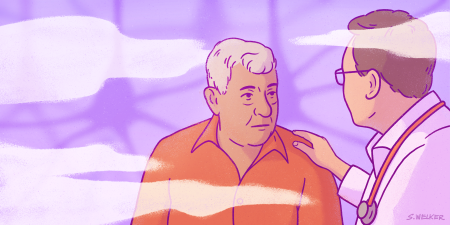Abstract
Delirium is common and increases in prevalence with age and medical complexity. A form of acute brain dysfunction, its presence is associated with significant morbidity, such as cognitive impairment, decreased mobility, depression, and institutionalization, as well as mortality. Many organizations have developed clinical protocols to prevent and treat delirium and what are called “cognitive-friendly” policies to care for elderly patients.
The physician must be able to tell the antecedents, know the present, and foretell the future —must mediate these things, and have two special objects in view with regard to disease, namely, to do good or to do no harm.
Hippocrates1
Delirium as Acute Brain Dysfunction
Delirium, characterized by acute deficits in cognition and attention with specific alterations in ability to focus, sustain, or shift attention, is unfortunately a common and highly morbid condition that is often underrecognized. A 2020 meta-analysis of 33 studies of medical adult inpatients found an overall delirium prevalence of 23%.2 This figure, however, underestimates the prevalence of delirium in critically ill and palliative care patients, which is estimated to be 32% and 75%, respectively.3,4 Delirium is associated with poor outcomes, including worse cognition and increased postdischarge mortality and hospital length of stay.5,6 In addition, delirium has been associated with new onset posttraumatic stress disorder, depression, and dementia.7,8,9,10 Delirium affects more than 2.3 million older Americans annually, complicating 17.5 million inpatient days.11 It was estimated in 2008 that delirium costs up to $64 421 per inpatient and costs the health care system between $38 billion and $152 billion per year.12 Delirium disproportionately affects older patients and will therefore become an even larger issue as the population continues to age.13
Although delirium is preventable in 30% to 40% of inpatient cases,13 it is often underrecognized and undertreated in the hospital.13,14 Delirium is a multifactorial condition resulting from a combination of neuroinflammation, brain vasculature dysfunction, altered brain metabolism, imbalance in neurotransmitters, and impaired neuronal network connectivity.15 Other forms of acute organ dysfunction are routinely monitored for, such as pulse oximetry, telemetry, and creatinine for pulmonary, cardiac, and renal function, respectively. Not only do we monitor for these conditions, but we also actively prevent organ dysfunction through, for example, the national movement for prevention of hospital- or ventilator-acquired pneumonia, avoidance of multiple QT-prolonging medications, and fluid resuscitation in the setting of acute kidney injury. In contrast, although strategies exist to prevent and mitigate harms from delirium, their implementation and reach is lacking. In this paper, we discuss the ethical considerations of implementing “cognitive-friendly” policies to prevent delirium among hospitalized older adults.
Evidence-Based Mitigation Strategies
Cognitive-friendly policies, or evidence-based strategies to prevent and mitigate harm from delirium, have been known for over 20 years.16 Consensus guidelines recommend general prevention interventions, such as orientation, normalization of the environment (eg, diet, utilization of hearing aids, music), promotion of sleep/wake cycle, treatment of pain, mobilization, and avoidance of deliriogenic medications such as benzodiazepines.17,18 Many of these recommendations have been combined into protocols or bundles. The Clinical Practice Guidelines for the Management of Pain, Agitation, and Delirium (PAD) in Adult Patients in the Intensive Care Unit (ICU) of the Society of Critical Care Medicine provide guidance for prevention of delirium.19 The ABCDEF (Assess and manage pain; Both spontaneous awakening and breathing trials; Choice of analgesia and sedation; Delirium: assess, prevent and manage; Early mobility and Exercise; and Family empowerment) bundle is a way to operationalize the PAD guidelines through ICU delirium prevention strategies.20 Adherence to this bundle is associated with a 40% reduction in likelihood of delirium on the day following exposure to the bundle.21 Additionally, implementation of this bundle has resulted in other clinically meaningful outcomes, such as reduced time on mechanical ventilation, time in a coma, and use of restraints. Finally, the Hospital Elder Life Program (HELP) is a targeted, multicomponent strategy to prevent functional and cognitive decline in hospitalized older persons.16 This bundle involves many members of the care team, as well as patients, and creates a personalized program using targeted interventions, such as daily visits, orientation, therapeutic activities, and more. The program has been shown to reduce the odds of delirium by 53%.22
Despite providers’ best efforts, delirium is not yet fully preventable; efforts must still be undertaken to mitigate its harm because the duration of delirium increases the risk of long-term cognitive impairment and mortality up to 2 years posthospitalization.23 While many risk factors for delirium—such as advanced age, baseline cognitive function, and frailty—are not modifiable, some are amenable to targeted risk reduction. For example, in the critical care setting, early physical and occupational therapy led to shorter delirium duration for adults who had been ventilated for less than 72 hours.24
As many interventions for risk factor modification are resource and labor intensive, interventions should be targeted to best utilize available resources. The PRE-DELIRIC model is an effective method to predict delirium in patients within 24 hours of admission to the ICU.25 This and similar models can and should be used for targeted risk factor modification for all—but especially for high-risk—patients.
Lack of Implementation
Despite the evidence pointing to the high prevalence of delirium, its associated morbidity, and opportunities to intervene, many institutions lack rigorous delirium prevention and mitigation strategies. Lack of recognition of delirium is one of the biggest barriers to its mitigation. Moreover, despite a clear recommendation to regularly assess for delirium in the PAD guidelines, 30% of ICUs in a worldwide survey conducted in 2016 never assessed for the presence of delirium.26 In those that did, only 42% used validated tools.26 Among all ICUs, only 31% to 67% implemented recommended nonpharmacologic practices, such as early mobilization, sleep promotion, and family participation,26 with the trend continuing in the inpatient setting, where up to 38% of patients in one study experienced delayed mobilization.27
A possible cause of the incomplete implementation of the PAD guidelines are institutional barriers. Commonly cited barriers to implementation of delirium prevention and mitigation strategies include strict visitation policies, lack of delirium training among nurses, and light and noise disturbances.28 Both presence of family at the bedside and environmental optimization to maintain sleep/wake cycles are part of the evidence-based bundle for delirium prevention.18 As a result of the COVID-19 pandemic, many hospitals significantly limited the presence of family at the bedside, potentially undermining the hospital’s ability to adhere to delirium prevention bundles.28 The evidence-practice gap may also be attributed to a lack of prioritization of the needs of older adults with cognitive impairment and a low organizational strategic and financial investment in delirium, as well as to the fact that delirium is a condition that falls between specialties.29 It is crucial that health care workers collaborate to ensure that evidence-based practices are implemented and executed in a consistent manner.
Delirium is often an iatrogenic complication of hospitalization, yet implementation of delirium prevention strategies lags behind.
Delirium is often an iatrogenic complication of hospitalization, yet implementation of delirium prevention strategies lags behind other iatrogenic complications, such as falls, nosocomial infections like catheter associated urinary tract infections (CAUTIs), and pressure injuries. Similar to delirium, these other iatrogenic complications are recognized as major sources of morbidity and mortality. Yet these examples are more easily recognizable and lead to immediately visible ramifications, whereas delirium is a more recently recognized phenomenon that has less obvious—but no less prevalent—direct, negative effects. Moreover, in contrast to delirium, systemic, widely implemented practices to monitor, prevent, and mitigate harm from other iatrogenic complications have been broadly implemented. For example, in response to the problem of catheter-associated urinary tract infections (CAUTIs), both the Centers for Disease Control and Prevention (CDC) and the Institute for Healthcare Improvement (IHI) put out guidelines on best practices for prevention.30,31 To incentivize enforcement, the Centers for Medicare and Medicaid Services stopped reimbursing costs associated with hospital-acquired CAUTIs. Since then, over 90% of US hospitals have implemented CAUTI-prevention bundles, resulting in an over 80% reduction in CAUTI rates at one medical center.32,33,34 Institutions should learn from this example and give both attention and funding to implementation of delirium prevention and mitigation strategies.
Iatrogenic Harm Avoidance
Reducing the prevalence of delirium and falls associated with delirium could result in an estimated $16 billion in savings annually.35 In addition to cost savings, reducing delirium would increase patient autonomy, as there is a higher likelihood that patients who are delirious would lose decision-making capacity and that a surrogate or legally authorized representative would have to make important medical decisions for them. By not implementing the nonpharmacologic best practices outlined above, we are thus allowing the health care system to potentially do harm to our patients.36
We could prevent significant morbidity and mortality associated with delirium if only hospitals, clinicians, and nursing staff would buy into the value of prevention and harm reduction. This buy-in, however, would require national-level policies from organizations like the CDC and IHI that push for bundles of delirium care. In addition, payers should also have to incentivize delirium-reduction bundles.
Despite the evidence in support of HELP and the ABCDEF bundle, there is a profound lack of policies to accelerate their implementation. Experts in this field have termed this lack the “know-do” gap.37 While we know what programs work, hospitals are not implementing them properly. It is an ethical imperative for hospitals and policy makers to address underlying challenges, such as excess burden on nursing, financial incentives, and other system-level problems. Only when this is done can a multicomponent program on delirium succeed.
Priorities
As alluded to above, perhaps delirium does not receive the attention it deserves because the patients it most significantly affects are older adults, frail or complex patients, and the cognitively impaired.38 These populations have been historically neglected in societal policies. Because they are less likely to have access to resources and to advocate for themselves, issues affecting them are not at the forefront of hospital policies. However, older adults make up the largest proportion of hospitalized patients in the American health care system.39 If we are to provide equitable care for all patients,36,40 we must make delirium care a priority in policy and practice. As we are lacking in prevention of delirium in hospitalized patients, we are inequitably doing harm to the most vulnerable populations.
There are policies we can and should implement to mitigate delirium’s prevalence and resulting mortality in hospitalized older adults. Hospital administration must emphasize programs such as the ABCDEF bundle and HELP. But policies are not enough; we must stay true to their intent by practicing in accordance with these policies, as we have an ethical responsibility to our patients to avoid the largely iatrogenic harms of delirium and to treat delirium as a pressing issue deserving of our attention and action. Finally, to truly practice with justice, we must prioritize the most vulnerable patients, as this issue most affects them.
References
-
Hippocrates. Of the Epidemics. Book I. Adams F, trans. Accessed June 6, 2023. http://classics.mit.edu/Hippocrates/epidemics.1.i.html
- Gibb K, Seeley A, Quinn T, et al. The consistent burden in published estimates of delirium occurrence in medical inpatients over four decades: a systematic review and meta-analysis study. Age Ageing. 2020;49(3):352-360.
-
Salluh JI, Soares M, Teles JM, et al; Delirium Epidemiology in Critical Care Study Group. Delirium epidemiology in critical care (DECCA): an international study. Crit Care. 2010;14(6):R210.
- Harris D. Delirium in advanced disease. Postgrad Med J. 2007;83(982):525-528.
-
Pandharipande PP, Girard TD, Jackson JC, et al; BRAIN-ICU Study Investigators. Long-term cognitive impairment after critical illness. N Engl J Med. 2013;369(14):1306-1316.
- Cole M, McCusker J, Dendukuri N, Han L. The prognostic significance of subsyndromal delirium in elderly medical inpatients. J Am Geriatr Soc. 2003;51(6):754-760.
- Saczynski JS, Marcantonio ER, Quach L, et al. Cognitive trajectories after postoperative delirium. N Engl J Med. 2012;367(1):30-39.
- Reston JT, Schoelles KM. In-facility delirium prevention programs as a patient safety strategy: a systematic review. Ann Intern Med. 2013;158(5, pt 2):375-380.
- Pandharipande PP, Girard TD, Ely EW. Long-term cognitive impairment after critical illness. N Engl J Med. 2014;370(2):185-186.
- Lin SM, Huang CD, Liu CY, et al. Risk factors for the development of early-onset delirium and the subsequent clinical outcome in mechanically ventilated patients. J Crit Care. 2008;23(3):372-379.
-
Agnoletti V, Ansaloni L, Catena F, et al. Postoperative delirium after elective and emergency surgery: analysis and checking of risk factors. A study protocol. BMC Surg. 2005;5:12.
- Leslie DL, Marcantonio ER, Zhang Y, Leo-Summers L, Inouye SK. One-year health care costs associated with delirium in the elderly population. Arch Intern Med. 2008;168(1):27-32.
- Bolton C, Thilges S, Lane C, Lowe J, Mumby P. Post-traumatic stress disorder following acute delirium. J Clin Psychol Med Settings. 2021;28(1):31-39.
- Inouye SK, Westendorp RGJ, Saczynski JS. Delirium in elderly people. Lancet. 2014;383(9920):911-922.
- Siddiqi N, House AO, Holmes JD. Occurrence and outcome of delirium in medical in-patients: a systematic literature review. Age Ageing. 2006;35(4):350-364.
- Inouye SK, Bogardus ST Jr, Charpentier PA, et al. A multicomponent intervention to prevent delirium in hospitalized older patients. N Engl J Med. 1999;340(9):669-676.
-
Wilson JE, Mart MF, Cunningham C, et al. Delirium. Nat Rev Dis Primers. 2020;6:90.
-
Hughes CG, Boncyk CS, Culley DJ, et al; Perioperative Quality Initiative (POQI) 6 Workgroup. American Society for Enhanced Recovery and Perioperative Quality Initiative joint consensus statement on postoperative delirium prevention. Anesth Analg. 2020;130(6):1572-1590.
- Devlin JW, Skrobik Y, Gélinas C, et al. Clinical practice guidelines for the prevention and management of pain, agitation/sedation, delirium, immobility, and sleep disruption in adult patients in the ICU. Crit Care Med. 2018;46(9):e825-e873.
- Marra A, Ely EW, Pandharipande PP, Patel MB. The ABCDEF bundle in critical care. Crit Care Clin. 2017;33(2):225-243.
- Pun BT, Balas MC, Barnes-Daly MA, et al. Caring for critically ill patients with the ABCDEF bundle: results of the ICU liberation collaborative in over 15,000 adults. Crit Care Med. 2019;47(1):3-14.
- Hshieh TT, Yang T, Gartaganis SL, Yue J, Inouye SK. Hospital elder life program: systematic review and meta-analysis of effectiveness. Am J Geriatr Psychiatry. 2018;26(10):1015-1033.
- Witlox J, Eurelings LS, de Jonghe JF, Kalisvaart KJ, Eikelenboom P, van Gool WA. Delirium in elderly patients and the risk of postdischarge mortality, institutionalization, and dementia: a meta-analysis. JAMA. 2010;304(4):443-451.
- Schweickert WD, Pohlman MC, Pohlman AS, et al. Early physical and occupational therapy in mechanically ventilated, critically ill patients: a randomised controlled trial. Lancet. 2009;373(9678):1874-1882.
- Linkaitė G, Riauka M, Bunevičiūtė I, Vosylius S. Evaluation of PRE-DELIRIC (PREdiction of DELIRium in ICu patients) delirium prediction model for the patients in the intensive care unit. Acta Med Litu. 2018;25(1):14-22.
- Morandi A, Piva S, Ely EW, et al. Worldwide survey of the “Assessing pain, both spontaneous awakening and breathing trials, choice of drugs, delirium monitoring/management, early exercise/mobility, and family empowerment” (ABCDEF) bundle. Crit Care Med. 2017;45(11):e1111-e1122.
-
Anada S, Iigaya M, Takahashi M, Soda K, Wada N. Impact of early mobilization on the duration of delirium in elderly hospitalized patients: a retrospective cohort pilot study. Medicine (Baltimore). 2022;101(44):e31641.
- Marmo S, Milner KA. From open to closed: COVID-19 restrictions on previously unrestricted visitation policies in adult intensive care units. Am J Crit Care. 2023;32(1):31-41.
- Grealish L, Chaboyer W, Mudge A, et al. Using a general theory of implementation to plan the introduction of delirium prevention for older people in hospital. J Nurs Manag. 2019;27(8):1631-1639.
-
Gould CV, Umscheid CA, Agarwal RK, Kuntz G, Pegues DA; Healthcare Infection Control Practices Advisory Committee. Guideline for prevention of catheter-associated urinary tract infections 2009. Infect Control Hosp Epidemiol. 2010;31(4):319-326.
-
Institute for Healthcare Improvement. How-to guide: prevent catheter-associated urinary tract infection. Institute for Healthcare Improvement; 2011.
-
Taha H, Raji SJ, Khallaf A, et al. Improving catheter associated urinary tract infection rates in the medical units. BMJ Qual Improv Rep. 2017;6(1):u209593.w7966.
-
Van Decker SG, Bosch N, Murphy J. Catheter-associated urinary tract infection reduction in critical care units: a bundled care model. BMJ Open Qual. 2021;10(4):e001534.
- Saint S, Greene MT, Fowler KE, et al. What US hospitals are currently doing to prevent common device-associated infections: results from a national survey. BMJ Qual Saf. 2019;28(9):741-749.
- Hshieh TT, Yue J, Oh E, et al. Effectiveness of multicomponent nonpharmacological delirium interventions: a meta-analysis. JAMA Intern Med. 2015;175(4):512-520.
-
Singer PA, Pellegrino ED, Siegler M. Clinical ethics revisited. BMC Med Ethics. 2001;2:1.
- Greysen SR. Delirium and the “know-do” gap in acute care for elders. JAMA Intern Med. 2015;175(4):521-522.
- Fitzpatrick AL, Powe NR, Cooper LS, Ives DG, Robbins JA. Barriers to health care access among the elderly and who perceives them. Am J Public Health. 2004;94(10):1788-1794.
-
Agency for Healthcare Research and Quality. Hospitalization in the United States, 2002. US Department of Health and Human Services. Accessed March 27, 2023. https://archive.ahrq.gov/data/hcup/factbk6/factbk6a.htm
-
Beauchamp TL. The “four principles” approach to health care ethics. In: Ashcroft RE, Dawson A, Draper H, McMillan JR, eds. Principles of Health Care Ethics. John Wiley; 2006:3-10.



